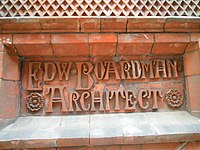Edward Boardman
| Edward Boardman | |
|---|---|

Sign outside the former office of Edward Boardman in Norwich
|
|
| Born |
Edward Boardman 1833 Norwich, England |
| Died | 1910 Norwich, England |
| Nationality | English |
| Occupation | Architect |
| Practice | Boardman and Son |
| Buildings |
Refurbishment of Norfolk and Norwich Hospital Conversion of Norwich Castle to museum |
Edward Boardman (1833–1910) was a Norwich born architect. He succeeded John Brown as the most successful Norwich architect in the second half of the 19th century. His work included both civic and ecclesiastical buildings, in addition to private commissions. Together, with his rival, George Skipper, he produced many notable buildings with several standing to this day (2013).
Boardman trained as an architect with the London-based company Lucas Brothers and was later articled with John Louth Clemence of Lowestoft. In 1860, he established his own practice in Norwich, before being accepted as a Fellow of the Royal Institute of British Architects (FRIBA) in 1871. From 1875, his offices were located at Old Bank of England Court, Queen Street, Norwich.
His major works in Norwich include the refurbishment of the Norfolk and Norwich Hospital, converting Norwich Castle into a museum, building the notable Royal Hotel and the mortuary chapel in the city's Rosary Cemetery. Outside of the city, he was responsible for the remodelling of Peckover House in Wisbech, the enlargement of Coltishall Primary School and in 1873, the building of the Dereham Congregational Church are among his most notable works.
Boardman was born in Norwich in 1833 and lived at 91 Newmarket Road, Norwich to his death on 11 November 1910. He was elected Mayor of Norwich for 1905–1906. Boardman retired in 1933 and the practice continued to 1966. He is buried at the city's Rosary Cemetery.
...
Wikipedia
